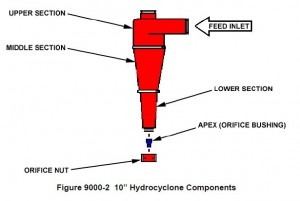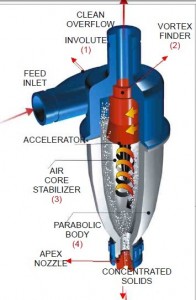Desander and desilter hydrociclones are device to separate particles from drilling fluid, which is sorted by shale shaker in the first phase of solids control system. You can see in the first picture.
 Usage of hydrocyclone
Usage of hydrocyclone
A hydrocyclone is often used to separate drilling cuttings from drilling mud originating at a desander desilter or some other continuous source of pressurized liquid. A hydrocyclone is most likely to be th
e right choice for processes where “lights” (drilling fluids, e.g.) are the greater part of the mixture and where the “heavies” (drilling cuttings e.g.) settle fairly easily.
How hydrocyclone works in desander and desilter
A hydrocyclone has two exits on the axis: the smaller on the bottom (underflow or reject) and larger at the top (overflow or accept). The underflow is generally the denser or thicker fraction, while the overflow is the lighter or more fluid fraction.
GN Solids Control provide hydrocyclone separator for oil gas drilling mud industry and mining slurry separation,HDD mud recycling and more.
